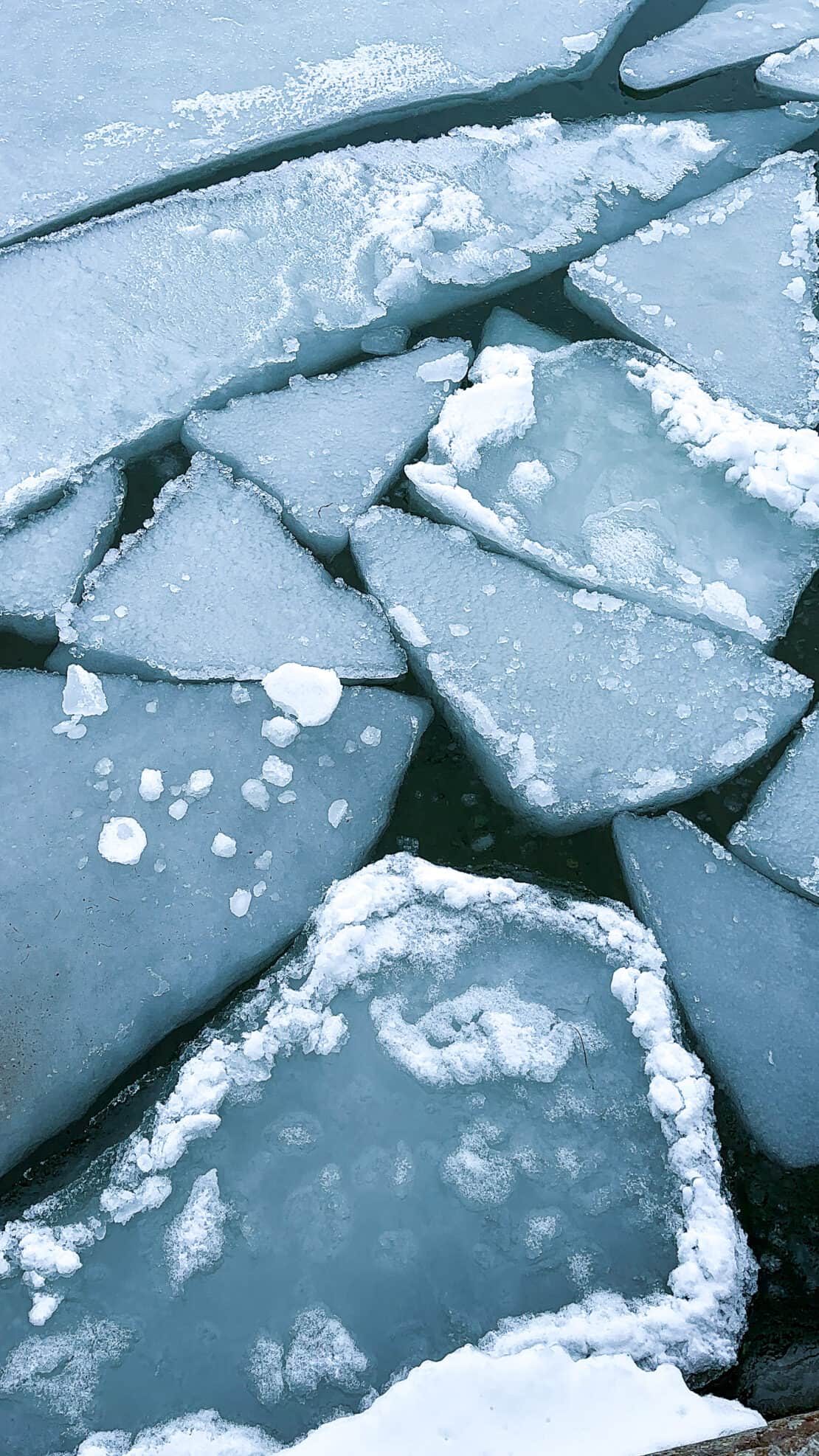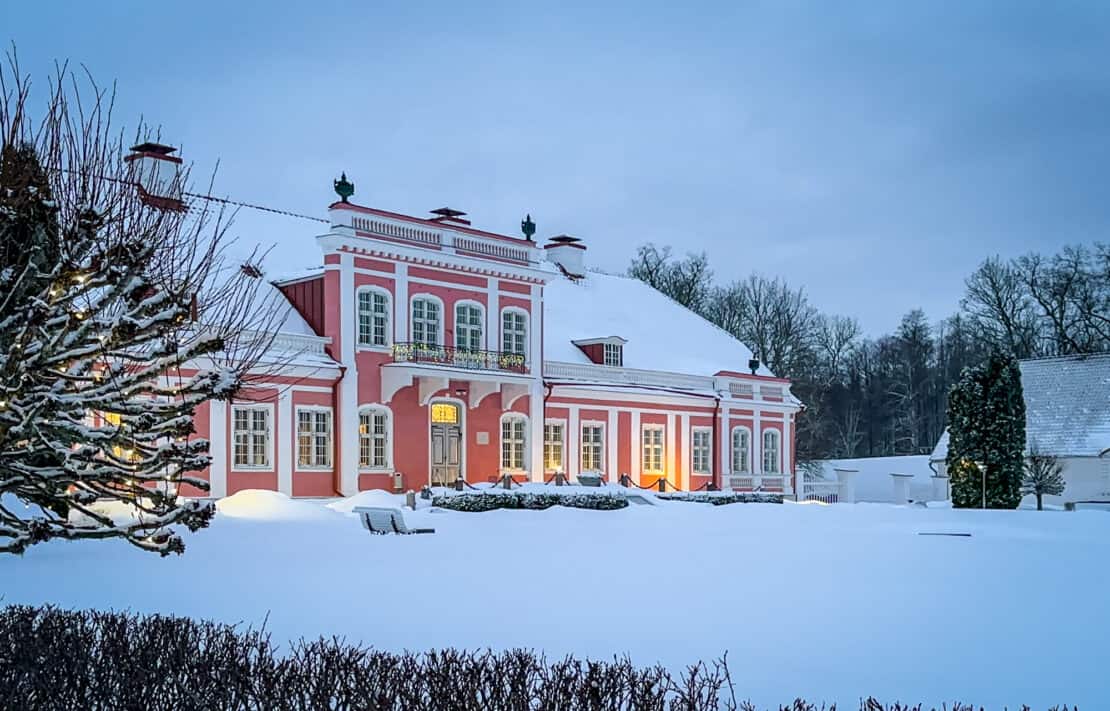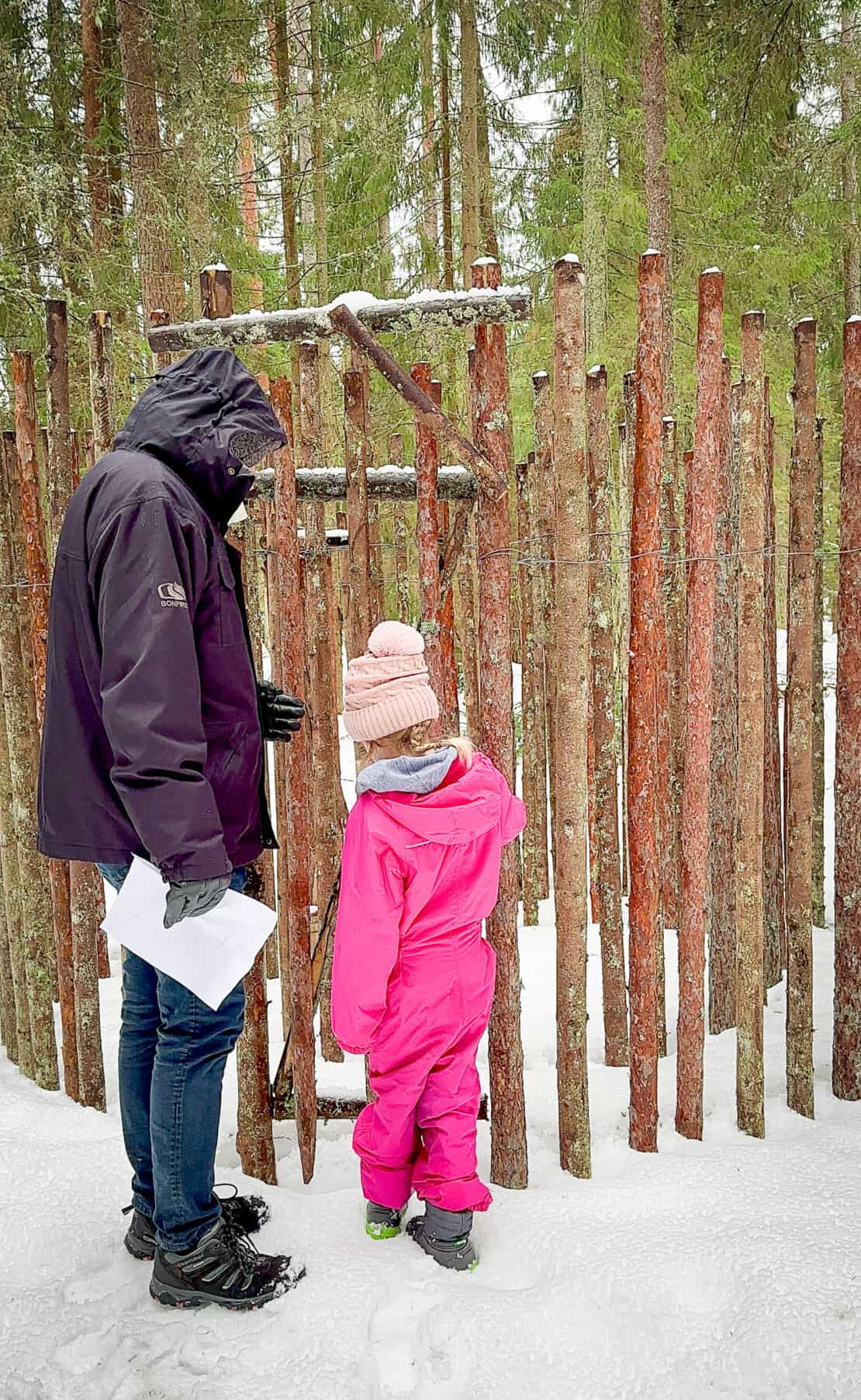Wondering how to visit Lahemaa National Park in winter? Don’t let snow on the ground put you off. Just an hour from Tallinn, you can explore Estonia’s oldest protected area as either a day trip or an overnight stay. Here’s how.

Visiting Lahemaa National Park in Winter
As soon as we started planning our trip to Estonia, people started talking about Lahemaa National Park. And it’s easy to see why. It’s beautiful, with beaches, hiking trails, bog trails, historic manors and more, one of Europe’s most recommended places to visit in this part of the world.
The only snag? We were visiting Estonia in February.
At this point, Visit Estonia suggested that perhaps we should head inland where the snow is more reliable but I’m so glad that we took the chance instead.
We had the place to ourselves, out footsteps the only ones crunching through the snow. Our voices the only ones mingling with the birdsong. And our breath the only one chilling in the air in puffs – apart from the few cosy cafes we found.
However. Visiting in winter is definitely visiting in the off season and plenty of places are closed.
Here’s what I believe you need to know as you plan your trip to Lahemaa.
Disclosure: this post may contain affiliate links, meaning we may earn a small commission if you book or buy through this article. This doesn’t cost you anything and we only recommend the good stuff. Ta!

Why Visit Lahemaa National Park
Not only is it a beautiful place but it’s a park near Tallinn, a city that most people stop off in at some point in their Baltic itinerary. It’s only a 40-60 minute drive from Tallinn, even in winter when there is snow on the ground. It makes for a fantastic day out as a day trip from the capital or a real winter escape if you have more time.
Lahemaa National Park has many of the natural sights that makes Estonia proud: forests, manor houses, bog trails and ancient coastal landscapes.
When to Visit
Winter in Estonia runs from December to March and while snow isn’t guaranteed for all of this time, you would be pretty unlucky to miss it.
Lahemaa National Park Information
What is it?
Lahemaa National Park is the first and largest national park in Estonia, founded on July 1, 1971.
Location:
Situated along Estonia’s northern coast, Lahemaa National Park spans the counties of Harju and Lääne-Viru.
Size:
Covering an expansive area of about 725 square kilometers, Lahemaa is known for its diverse landscapes, including forests, wetlands, lakes, and coastal areas.
Biodiversity:
Lahemaa supports numerous plant and animal species, including several rare and endangered ones including bears, lynx, wolves and moose.
Historical Significance:
The park is home to numerous historical and cultural sites, including old manor houses, fishing villages, and archaeological sites, providing insights into Estonia’s heritage.
Coastline:
Lahemaa’s northern boundary is defined by a rugged and picturesque coastline along the Gulf of Finland, featuring limestone cliffs and sandy beaches. Head to Purekkari Cape to see the northernmost point.
Visitor Attractions:
Explore hiking trails and nature walks to opportunities for birdwatching and wildlife observation. Sleep and dine in old manor houses and visit forestry museums.
Manors and Estates:
Lahemaa is known for its well-preserved manor houses, such as Palmse and Sagadi, providing visitors a glimpse into the region’s historical aristocratic lifestyle.
Flora and Fauna:
The diverse ecosystems within the park showcase a variety of plant life, including ancient forests and unique coastal vegetation, supporting a wealth of animal species.
Accessibility:
Located near the capital city, Tallinn, Lahemaa National Park is a short drive away. Once in the park, it’s best to get around by car or with a tour group as public transport is limited.
Conservation Efforts:
Lahemaa plays a crucial role in preserving Estonia’s natural heritage, and conservation efforts are ongoing to protect its ecosystems and maintain its ecological balance.

How to Visit Lahemaa National Park in Winter
To be honest, visiting this nature reserve is easiest as part of a self drive adventure, by far. In winter, many places are closed and so it’s far easier to drive on to the next spot rather than stand around in the cold, waiting for public transport. Car rental is inexpensive and easy to pick up from Tallinn airport.
That said, there are frequent connections between Tallinn and the Viru Bog Trail, a popular route where boardwalks cover the bog surrounded by the snowy landscape.
With a car, however, you can visit many of the other stops. Stops like…
Võsu
By summer, this is clearly a beach resort town, with burger shacks and a beach playground amid pretty painted coloured houses.
In winter, the shore was frozen and the beach an endless stretch of snow.
We found one pub and one alone open, serving standard pub grub and a few Estonian specialties like mudpilger and chicken with an apricot and brandy sauce. Other recommended villages include Altja and Viinistu.
Northern Cape Point
We never made it to this point as the daylight was running out. However, it was recommended as the northernmost part of the country. Perched along the shores of the Gulf of Finland, this point offers a panorama of limestone cliffs, wind-sculpted trees, and the expanse of the Baltic Sea.
Hiking trails meander through the coastal forest and the Northern Cape is home to various bird species; during migration seasons, it becomes a haven for birdwatchers.

Oandu Visitor Centre
This cute little wooden spot offers plenty of different hiking trails as well as serving hot coffee and a dose of inspiration. The place lists many trails, including the Forest Fairy and Beaver Trail but we followed the guide’s recommendation to take on the 3km or so Cultural Heritage Trail.
There, alone amid the trees, we discovered knobbly black fungus that clings to silver birches, handmade wolf traps, arrrowmarks from tree sap procedures and the fire lines introduced by the Baltic Germans. The park is home to bears, lynx, wild boars and wolves – and while we didn’t see them directly, we did see signs of animal activity.
The route was doable with a seven year old and the unspoiled snowy nature of it. The hike isn’t difficult and with so much fresh snow around, it’s reassuring to know you’re walking on a defined trail rather than about to drop into a concealed bog.
Mostly, though, we just got to walk amid snowy forests in peace. It was an absolutely brilliant day and the hike was stunning.
You can find the little centre between Sagadi and Altja (or, with a bit of luck, on Google maps.)

Sagadi Manor
This gorgeous bite of pink pastel pretty looks perfect decked out in twinkling lights in winter. You can visit the Manor House itself and see how Estonia spent its Downton Abbey era, with hunting rifles, servants quarters, drawing rooms and the like. The next door Forest Museum is an absolute delight, all fresh and innovative with interactive exhibits that walk you through everything from birdsong to heavy industry in the forest. The restaurant at the Sagadi Manor hotel serves a good range of local dishes and has a lovely wooden play area in the room itself for kids.
Look out for the stuffed boar downstairs: it’s the largest to ever be found in Estonia.

Tours to Lahemaa National Park
Of course, sometimes it’s just easier to book a tour, particularly if you want to take part in an organised activity like snowshoeing or rural trekking. A tour in Lahemaa typically leaves from Tallinn. Here are some recommended options:
- Day trip to Lahemaa National Park: 7-hour excursion from Tallinn including a local guide and visit to Jägala Waterfall
- Lahemaa National Park day trip with snacks: 8-hour trip from Tallinn including hiking through the Viru Bog trail and a visit to Käsmu Captains Village
- Guided tour of Estonian nature trails: private 7-hour tour with a heavy focus on nature and walking
Where to Stay in Lahemaa National Park
The best way to enjoy this snowy masterpiece is to stay in or near Lahemaa park itself. You’ll find gorgeous, repurposed manor houses set in sumptuous grounds so that the accommodation itself feels like part of the experience.
If you do this, then it’s really time to have considered renting a car as it will make everything so much easier. And discovering fascinating places is part of the charm.
Here are some top spots.
Sagadi Manor
This gorgeous spot is perfect for winter. We loved the in-room sauna, although not all have them, so check while booking. You can book direct on the Sagadi Manor website here.
Vihula Manor
The Vihula Manor Country Club and Spa is an upscale eco-certified hotel located in Lahemaa National Park.
Here you can indulge in aromatherapy, massage and facials at the on-site spa, enjoy a meal at the two on-site restaurants and make use of the gym. Additional perks includ a swimming pool with cabanas and sunloungers and bike hire.
- Prices start from £89. Book your room at the Vihula Manor Country Club and Spa here.
Palmse Manor
Palmse Manor stands as one of Estonia’s most magnificent baroque mansions. It represents the first fully restored manor complex in the country, encompassing both the mansion and an open-air museum. The open-air museum showcases meticulously maintained parks, gardens, and historical buildings, hosting exhibitions, workshops, a training centre, a wine cellar, a romantic café, and a tavern serving national dishes.
You can book your room at Palmse Manor here.

What to Pack for Estonia in Winter
Estonia in winter is beautiful but cold. Temperatures can easily dip to minus ten degrees and even in the city you can find snow on the ground as late as February. Please dress accordingly.
So, pack layers. Lots of layers. Plus, hiking boots or snow boots and, ideally, some waterproof trousers and a ski jacket or otherwise tough, warm coat. Don’t forget the obvious accessories like a warm hat and gloves, a scarf and decent hiking socks. And I’d strongly suggest packing thermal trousers and tops and a single fleece, with pockets, so that you can stay comfy in the cold. Or, if you’re American, pack skiing pants and a warm hat.
See our guides to what to pack for a hiking checklist and our ultimate travel packing checklist here.
What to Eat in Lahemaa National Park
Keep an eye out for these specialities:

Mudpilger Porridge
Mudpilger porridge is a traditional Estonian dish known for its hearty and comforting nature. Comprising a blend of grains, typically barley and oats, this porridge is often enriched with local ingredients like berries or nuts for added flavour and nutritional value. Its rustic appeal makes it a staple, reflecting Estonia’s culinary heritage and a preference for wholesome, locally-sourced ingredients.

Vana Tallinn
Vana Tallinn is a beloved Estonian liqueur. This spiced rum-based drink features a unique blend of flavours, including vanilla, cinnamon, and citrus, creating a warm and aromatic profile. Often enjoyed neat or as part of cocktails, Vana Tallinn is a symbol of Estonia’s hospitality. We tasted some at an impromptu Valentine’s day singing service at Sagadi Manor.
Game Dishes
Game dishes in Estonia often showcase the country’s rich natural landscapes and hunting traditions. Wild game, such as venison, boar, or duck, is prepared in various ways, from roasting to stewing, highlighting the robust flavours of the meat.

More About Travel in Estonia
A trip to Lahemaa National Park in winter fits well into a 15 day itinerary through Estonia, Latvia and Lithuania. That way you get to see 3 beautiful countries around unspoiled coastal areas, plus top places worth visiting like Riga, Latvia’s art nouveau capital. Check out this article on what Latvia is famous for if you plan on visiting.




